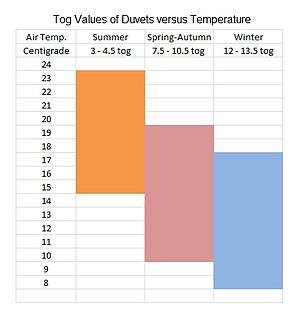Tog (unit)
The tog is a measure of thermal insulance of a unit area, also known as thermal resistance. It is commonly used in the textile industry and often seen quoted on, for example, duvets and carpet underlay.
The Shirley Institute in Manchester, England developed the tog as an easy-to-follow alternative to the SI unit of m2K/W.[1] The name comes from the informal word togs for 'clothing', which itself was probably derived from the word toga, a Roman garment.
The basic unit of insulation coefficient is the RSI, (1 m2K/W). 1 tog = 0.1 RSI. There is also a US clothing unit, the clo, equivalent to 0.155 RSI or 1.55 tog, described in ASTM D-1518.
A tog is 0.1 m2K/W. In other words, the thermal resistance in togs is equal to ten times the temperature difference (in °C) between the two surfaces of a material, when the flow of heat is equal to one watt per square metre.[1]
British duvets are sold in steps of 1.5 tog from 4.5 tog (summer) to 16.5 tog (extra-warm). The stated values are minimum, actual values may be up to 3 tog higher. These tog values assume that there is no duvet cover added that can trap air.

| Lightweight summer duvet: | 3.0 - 4.5 tog |
| Spring/Autumn weight duvet: | 7.5 - 10.5 tog |
| Winter weight duvet: | 12.0 - 13.5 tog |
A few manufacturers have marketed combined duvet sets consisting of two duvets; one of approximately 4.5 tog and one of approximately 9.0 tog. These can be used individually as summer (4.5 tog) and spring/autumn (9.0 tog). When joined together using press studs around the edges, or Velcro strips across each of the corners, they become a 13.5 tog winter duvet and as such can be made to suit all seasons.
Testing
Launched in the 1940s by the Shirley Institute, the Shirley Togmeter[2] is the standard apparatus for rating thermal resistance of textiles, commonly known as the Tog Test. This apparatus, described in BS 4745:2005,[1] measures a sample of textile, either between two metal plates (for underclothing) or between a metal plate and free air (for outer layers).
Each industry has its own specifications and methods for measuring thermal properties. The Shirley Togmeter is claimed to be unsuitable for duvets because the large scale of their quilted construction makes it impractical to obtain a representative sample of suitable size. BS5335 describes apparatus for duvet tog testing.[2]This consists of a metal plate at least 1000 mm x 600 mm at skin temperature (33°C) arranged to support the whole duvet, and a mechanism for measuring the air temperature above the quilt. This requires very precise control of the laboratory environment in order to get reliable results.
BS 8510 describes tog testing for baby products, the concern here being to ensure that babies do not overheat, with a maximum tog rating of about 4.[2] BS 8510 has since been withdrawn and replaced by BS EN 16781:2018.
See also
References
- Kennard, Harry (March 7, 2017). "What's a Tog".
- Tim Jackson (19 December 2013). "Measurement of area thermal resistance". tim-jackson.co.uk. Retrieved 27 December 2018.